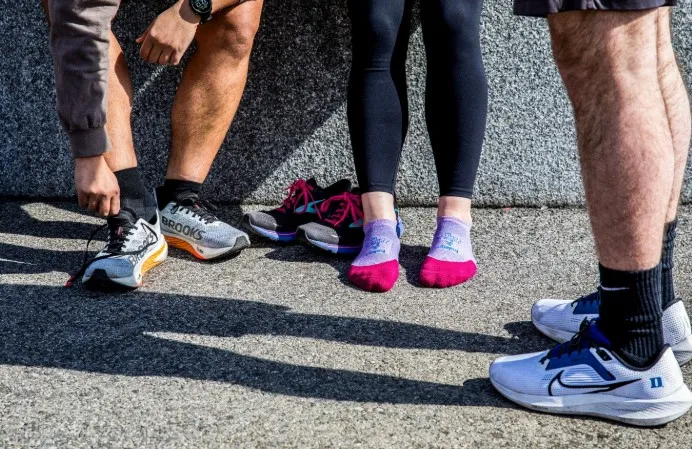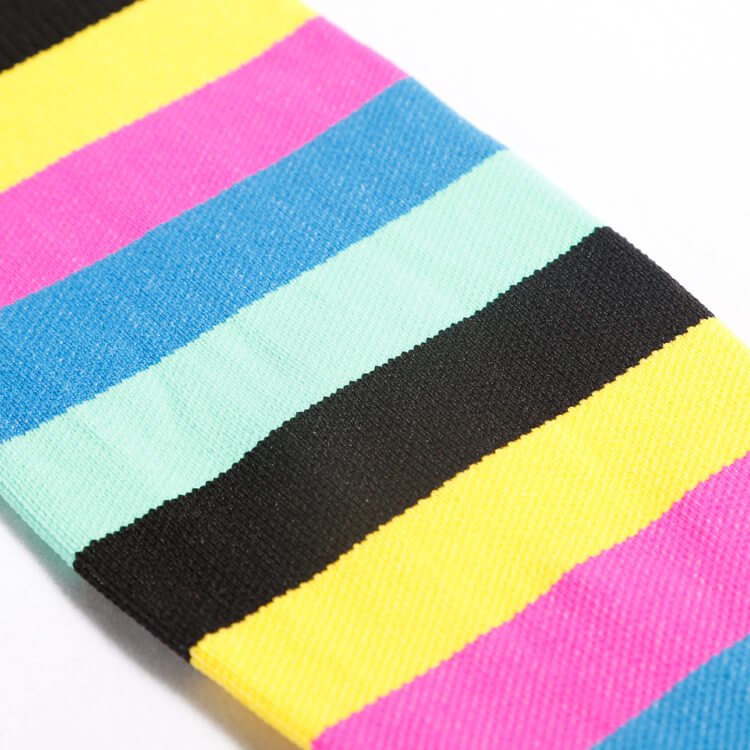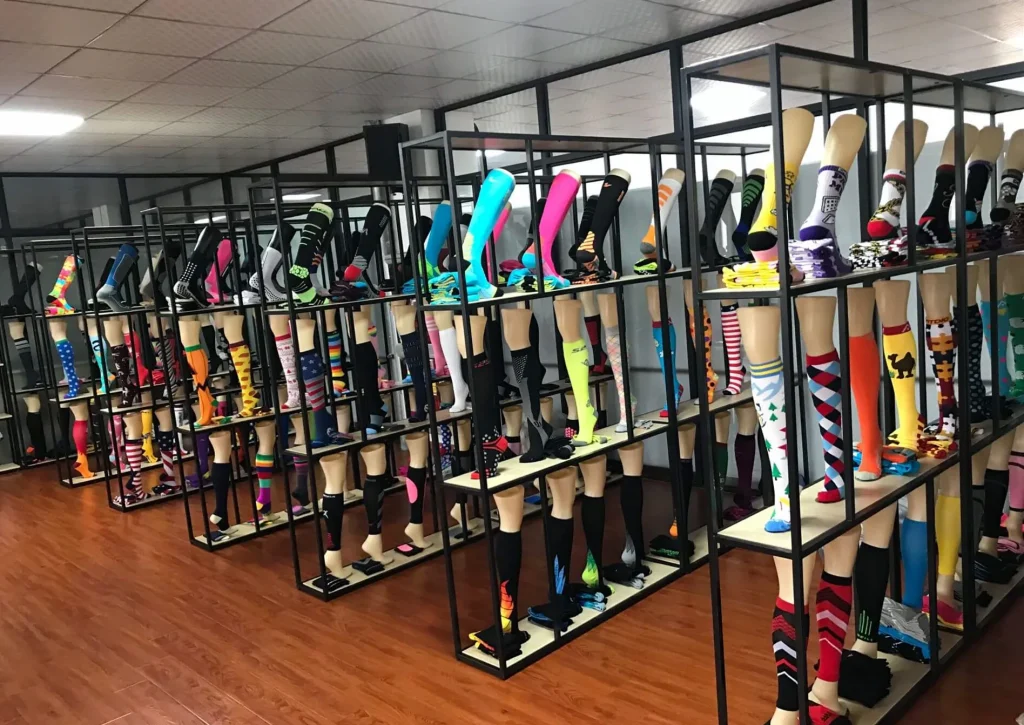The running community has witnessed a remarkable evolution in athletic apparel over the past decade, with vibrant colors and bold designs replacing the once-dominant neutral palettes of traditional sportswear. Among these colorful innovations, pink running socks have emerged as a particularly interesting phenomenon—transcending their basic function as foot coverings to become statement pieces that potentially influence both psychological state and physical performance. This exploration delves into the multifaceted impact of pink running socks, examining the psychological effects of color, practical benefits of high-visibility gear, and the complex interplay between appearance, confidence, and athletic performance that makes these seemingly simple accessories worthy of serious consideration for runners seeking every possible advantage.

The Psychology of Color: How Pink Affects Mood and Perception
Color psychology shows that different hues can evoke emotional responses, influencing perceptions and behaviors. But here’s the kicker… pink, once linked to femininity, is now embraced by all genders for its psychological benefits. Pink is associated with nurturing, compassion, and optimism, creating a positive emotional response that helps counterbalance physical stress during athletic activities.
The shade of pink matters: softer pinks promote tranquility and comfort, while vibrant shades like hot pink or neon spark energy and excitement. This is why performance-oriented socks often feature these energizing pinks. Studies show exposure to pink can lower heart rate and reduce aggression, helping runners maintain composure during intense training or competition.
The psychological effects of color operate through neurological pathways that connect directly to emotional centers in the brain, influencing mood and perception below conscious awareness. Ready for the good part? for runners, this subconscious impact is particularly valuable during long efforts, when mental fatigue makes emotional regulation and performance more challenging.
Visibility and Safety: Practical Benefits of Bright Running Socks
Bright pink socks offer significant safety benefits for runners, especially in low-light or urban environments. But here’s the kicker… research shows that enhanced visibility reduces accident risks by increasing the distance at which runners are noticed by motorists, providing drivers with crucial extra seconds to react. Pink is particularly effective due to its rarity in nature, making it stand out more than other colors. This visibility isn’t just for drivers—cyclists and pedestrians also benefit, reducing collision risks on shared paths.
The visibility boost is especially important during dawn, dusk, or overcast conditions, when lighting is low but not dark enough to require reflective gear. Bright colors like pink work passively, enhancing safety without needing power sources. Many runners pair bright socks with reflective elements on upper garments to ensure visibility from all angles. For trail runners, pink socks help emergency responders spot injured runners in natural settings, potentially saving valuable time in critical situations.
The Confidence Factor: Looking Good to Feel Good
The relationship between appearance and self-confidence is a key psychological factor that can impact performance, especially with items like pink running socks. Research in sports psychology shows that athletes who feel good about their appearance tend to perform better. This “enclothed cognition” effect suggests that what we wear can positively influence our mindset and abilities.
Bright pink socks, for example, create a sense of uniqueness, making runners feel memorable rather than anonymous. This visibility can boost their commitment to performance, especially when they seek social recognition or community connection. Additionally, choosing distinctive gear reflects personal agency, which is strongly linked to increased confidence and empowerment. Many runners report that wearing eye-catching gear helps them feel more connected to their runner identity and motivates them to live up to the image they project, regardless of whether others notice.
For runners, particularly those who have felt marginalized in the past, bold choices like pink socks serve as a psychological declaration of belonging, especially for newcomers or those returning to running after a break.
Performance Psychology: The Placebo Effect in Athletic Gear
The placebo effect occurs when belief in a treatment’s effectiveness leads to real physiological benefits, even without active ingredients. In sports, research shows that athletes who believe their equipment improves performance often experience measurable improvements, even when the gear doesn’t contain any performance-boosting technology. This psychological effect reduces perceived effort, allowing athletes to push harder without feeling more exertion. The placebo response also triggers real physiological changes, such as improved muscle recruitment and altered hormone levels. For runners, believing their pink socks enhance performance—whether for luck, visibility, or confidence—can lead to tangible improvements. These effects can be significant, with some studies showing performance boosts of 1-5%, which can be crucial in competitive settings. This explains why many athletes have superstitions or preferences for specific equipment, as the psychological benefits may improve their actual performance.
Technical Considerations: Beyond Color to Function
The psychological and visibility benefits of pink running socks are worth considering, but the core performance features are still paramount. The construction impacts comfort, blister prevention, moisture management, and durability. Material choice is critical—synthetic fibers like nylon and polyester excel in moisture-wicking and drying quickly, preventing blisters during long runs. Merino wool, known for its temperature regulation, is popular for its warmth in cold weather and breathability in moderate conditions, as well as its antimicrobial properties to manage odor.
Many premium running socks combine synthetic and natural fibers for optimal performance, using synthetic materials where moisture is high and wool where temperature control and comfort are crucial. Construction techniques like seamless toe closures, anatomical shaping, and targeted cushioning reduce friction and improve fit. Thinner socks offer better ground feel and work well in tighter shoes, while cushioned socks provide more impact protection but can compromise shoe fit. But here’s the kicker… while color adds aesthetic appeal, the performance of pink socks should be evaluated based on these technical factors, just like any other running sock.
Gender Marketing in Athletic Wear: Breaking Stereotypes
The evolution of pink running socks in the athletic apparel market highlights shifts in how gender influences marketing and consumer choices. Traditionally, pink was heavily marketed to women, with products often receiving less technical development than their male counterparts and focusing primarily on color rather than performance. However, today, pink transcends gender boundaries, embraced by all identities, driven by cultural shifts and the growing presence of male athletes confidently wearing pink.

Modern athletic brands have adopted more inclusive marketing, presenting color choices as personal rather than gender-based. This shift encourages self-expression and challenges old limitations on color associations. For women, reclaiming pink offers a form of empowerment, as it allows the embrace of traditionally feminine aesthetics while excelling athletically. For men, the growing acceptance of pink reflects a broader societal shift toward more flexible expressions of masculinity, helping dismantle stereotypes that previously limited athletes’ choices.
Social Signaling on the Running Trail
Distinctive pink running socks offer both functional and social benefits. But here’s the kicker… they serve as powerful social signals within running communities, indicating identity, affiliations, and values. Bright colors like pink often represent membership in specific running clubs, events, or training groups, helping members recognize one another and strengthen community ties. These socks are not just a personal choice—they represent a declaration of belonging to a shared goal or culture.
Brand communities also form around distinctive apparel, with some sock brands gaining a loyal following among subcultures. Ready for the good part? these visual cues foster immediate connections between runners who share a passion for particular brands, often sparking spontaneous conversations during events. Social media amplifies this effect, as visually striking items like pink socks gain additional social value by being featured in posts, helping content creators build recognizable personal brands.
Finally, wearing bold, expressive items like pink socks can signal a playful, joy-focused approach to running, as opposed to a strictly performance-driven mindset. This subtle form of value signaling allows like-minded runners to connect based on shared perspectives about the sport. As these social signals spread, distinctive items like pink socks become widely recognized and help strengthen bonds within running communities.
Compression Benefits: Functional Advantages Beyond Color
While the psychological impact of pink running socks is important, many performance options also offer compression benefits. But here’s the kicker… compression socks, especially those with graduated compression, enhance circulation by promoting venous return. The tightest part of the sock is at the ankle, gradually loosening up the leg, helping prevent blood pooling in the lower extremities. This improves oxygen delivery to muscles, which is crucial during extended physical activity.
Compression technology may also reduce muscle oscillation, minimizing fatigue over longer distances. Ready for the good part? runners on harder surfaces often find compression socks beneficial for stabilizing their muscles and reducing fatigue, whereas trail runners might not experience the same effects. During recovery, compression socks can help reduce muscle damage and inflammation, making them ideal for multi-day events or intensive training periods.
Despite the physical benefits, many runners also report subjective improvements, such as reduced perceived exertion and fewer minor discomforts. While these may reflect placebo effects, they contribute to a better running experience and improved workout quality. This is where it gets interesting… for maximum effectiveness, proper sizing and the right compression levels (15-20 mmHg for moderate activity, 20-30 mmHg for longer distances or recovery) are key. This ensures that both the aesthetic and functional benefits of pink running socks work together to support performance.
Durability Concerns: Maintaining Vibrancy Through Washing
When investing in distinctive pink running socks, color retention is crucial for maintaining their visibility and appeal. But here’s the kicker… the dye quality and application methods determine how well the socks maintain their vibrant color over time. High-quality socks use advanced dyeing techniques, like reactive dyes, which chemically bond with fibers for superior wash resistance compared to direct dyes that simply adhere to the surface. This is one reason why premium socks cost more—they use better materials and more complex manufacturing processes.
Synthetic fibers like nylon and polyester hold color better than natural fibers, which is why performance socks often use them despite natural fibers offering more comfort in some situations. Ready for the good part? washing practices also play a big role in color longevity. Cold water washing preserves the dye bonds, while hot water can break them down. Mild detergents and avoiding bleach further protect color. Turning socks inside-out and air drying helps maintain their bright pink look.
For those looking to keep their socks looking fresh longer, using color-protecting detergents and color-catching sheets can further protect against fading. These products help preserve the vibrancy of your socks through more washes, keeping them in top shape for longer.
Seasonal Adaptations: Pink Socks for Different Running Conditions
Running socks must adapt to seasonal conditions while maintaining the visibility and psychological benefits of the pink aesthetic. But here’s the kicker… summer running socks focus on moisture-wicking synthetic fibers to prevent sweat buildup and friction-related issues like blisters. Thinner constructions and mesh ventilation zones enhance breathability, keeping feet cool during hot weather, while minimal cushioning reduces heat retention.
In contrast, winter running socks prioritize insulation and moisture management. Ready for the good part? pink socks designed for cold weather often feature thicker materials like wool or thermal synthetics to trap warmth and wick away moisture, preventing dangerous cooling. Higher cuff heights and windproof panels offer extra protection from the cold.
During transition seasons like spring and fall, mid-weight socks offer a balance between insulation and breathability. This is where it gets interesting… they provide some thermal protection without overheating, making them ideal for fluctuating temperatures. The moisture management capabilities of these socks are especially important during these unpredictable seasons, preventing sweat from accumulating.
Trail running requires additional durability and protection. But here’s the kicker… pink trail running socks are reinforced in high-wear areas like the heel and toe, often incorporating water-resistant treatments or debris-blocking cuffs to protect against rocks, thorns, and trail debris. These adaptations allow trail runners to keep their pink aesthetic while ensuring durability and protection during off-road adventures.
From Training to Race Day: Strategic Use of Statement Socks
Many runners strategically use distinctive apparel, like pink socks, to enhance performance by creating psychological triggers. But here’s the kicker… assigning specific gear to challenging workouts or races helps them transition into a focused mindset. Runners often report that using certain items for tough training days, such as bright pink socks, helps them mentally prepare for high-intensity efforts. This strategy relies on classical conditioning, where pairing unique visual cues with intense effort creates automatic associations, making it easier to enter a competitive mindset.
For race day, runners often save special items that remain unworn during training. Ready for the good part? The novelty of new gear like bright pink socks boosts psychological arousal and accountability during races, making runners more visible to spectators and motivating extra effort. Experienced runners develop layers of psychological triggers, reserving specific gear for different competition levels, ensuring maximum impact.
Research on enclothed cognition confirms that the symbolic meaning of certain garments, such as “lucky” socks worn during past successes, can influence performance by reducing anxiety and enhancing focus. These attachments explain why elite athletes often place emotional value on their gear, even though the physical properties remain unchanged.
Conclusion
Pink running socks represent the intersection of psychology, functionality, and social dynamics in athletics. But here’s the kicker… while it might seem like a simple color preference, bright pink can influence mood, energy, and stress responses, all of which impact performance—particularly during intense runs where mental fatigue can be a limiting factor. Many runners report increased confidence when wearing distinctive gear, reducing perceived exertion and allowing for harder efforts with less mental fatigue.

Practical benefits go beyond psychology. The visibility of bright pink socks can improve safety during low-light conditions, making them ideal for early morning or evening runs. Ready for the good part? this safety advantage alone justifies bright colors like pink, even without the psychological or social benefits. Socially, pink socks can foster connections within the running community, creating recognition opportunities and shared experiences.
Of course, the technical aspects—materials, construction, and seasonal adaptations—are just as important. The best pink running socks balance comfort, functionality, and color benefits, ensuring they protect your feet while enhancing the running experience. Ultimately, choosing pink socks depends on individual preferences, training context, and personal needs. Experimenting with different options will help runners discover what best suits their physical and psychological needs.
FAQ Section
Can the color of running socks actually improve performance, or is it just psychological?
While primarily psychological, these mental effects can create measurable performance improvements. Color psychology research shows pink can reduce stress and increase energy, potentially benefiting runners during challenging efforts. The confidence boost from distinctive gear also reduces perceived exertion, allowing harder efforts without corresponding mental fatigue.
Are pink running socks only marketed to women runners?
No, contemporary running brands increasingly offer pink options across all gender categories. While historically gender-coded, pink has transcended traditional associations in athletic contexts, with many male elite athletes embracing pink gear. Progressive brands now present colors as personal preference choices rather than gender signifiers.
Do pink socks offer any practical benefits beyond appearance?
Yes, bright pink significantly enhances visibility during low-light conditions, potentially improving safety on roads. The distinctive appearance also creates recognition among running communities and can facilitate social connections. Many pink options also incorporate performance technologies like compression or moisture-wicking that provide functional benefits regardless of color.
Will pink running socks fade quickly with regular washing?
Quality matters significantly. Premium brands use reactive dyes that bond chemically with fibers for superior color retention. To maintain vibrancy: wash in cold water, use mild detergents without brighteners, turn inside-out before washing, and air dry when possible. These practices can significantly extend the visual lifespan of bright colors.
Are there performance differences between pink socks and other colors?
Functionally, color doesn’t affect performance characteristics like moisture management or durability. However, psychological research suggests bright colors may enhance motivation and energy, while the confidence from wearing distinctive items can reduce perceived exertion. The visibility benefits of bright pink also provide safety advantages in low-light conditions.
